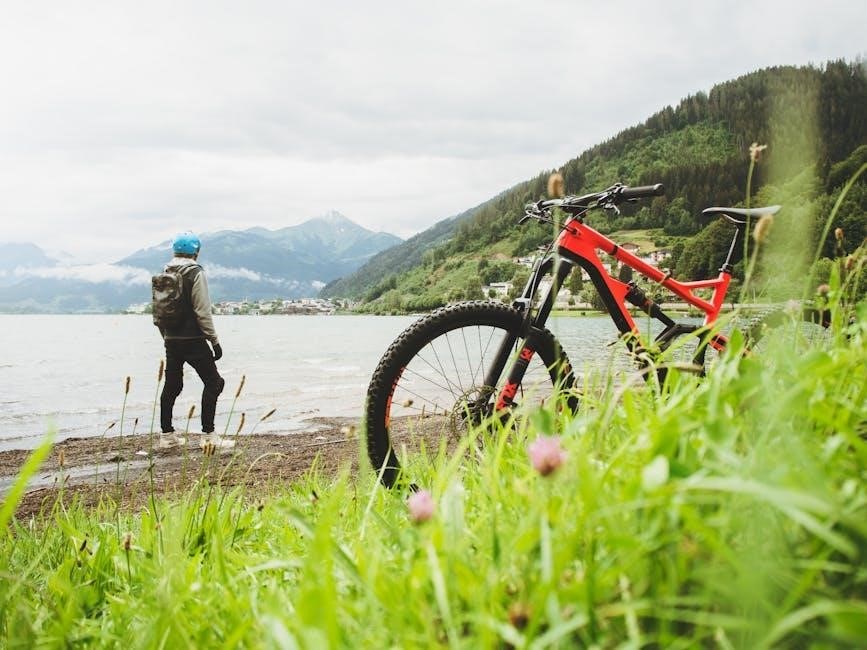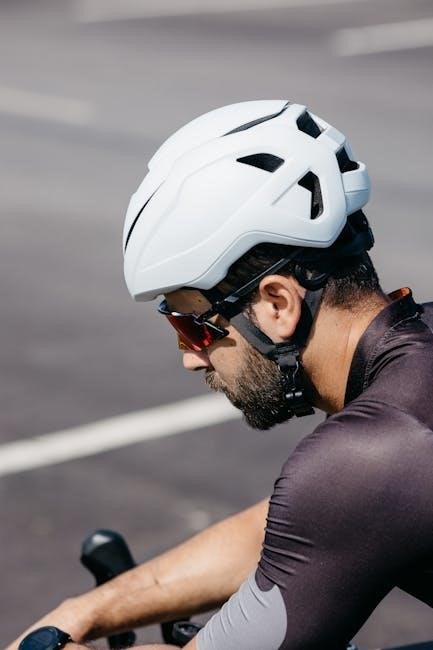Understanding bike wheel size and height is crucial for a perfect fit, optimal performance, and comfort. This guide helps riders choose the right bike dimensions for their needs.

Why Wheel Size and Bike Height Matter for Riders
Wheel size and bike height are critical for ensuring a proper fit, comfort, and optimal performance. A bike that is too small or too large can lead to discomfort, poor control, and even injury. Standover height and seat height are key measurements to assess fit, while wheel size impacts stability and handling. Larger wheels offer better stability and roll-over ability, while smaller wheels provide agility and portability. For riders, matching bike dimensions to body proportions ensures efficient pedaling and reduces strain; Whether for road, mountain, or hybrid bikes, getting the right size and fit is essential for an enjoyable and safe riding experience.


Understanding Bike Height Measurements

Bike height measurements ensure proper fit and comfort. Key measurements include standover height and seat height, which determine how well the bike aligns with your body proportions.
What is Standover Height and How to Measure It
Standover height is the measurement from the ground to the top of the bike’s top tube. It ensures proper clearance when standing over the bike. To measure, place the bike on a level surface and measure vertically from the floor to the highest point of the top tube. For road bikes, aim for about 1 inch of clearance, while mountain or hybrid bikes typically require 3 inches. This measurement helps determine if the bike is the right size for your body, ensuring safety and comfort while riding. Proper standover clearance prevents discomfort and potential injury, making it a critical factor in bike sizing.
How to Measure Seat Height for Optimal Comfort
Seat height is measured from the ground to the top of the saddle. To find the optimal height, wear cycling shoes and stand beside the bike. Place your heel on the pedal, with the pedal at the lowest point. Your leg should be almost fully extended, with a slight bend in the knee (about 10-15 degrees). Adjust the seat height so that when the pedal is at the 6 o’clock position, your heel barely reaches it without overextending. This ensures proper leg extension and prevents discomfort or strain. Start with the seat level and fine-tune based on your riding style and comfort preferences.

Understanding Bike Wheel Sizes
Bike wheel sizes vary, with common diameters like 26”, 27.5”, and 29” for mountain bikes, and 700c for road bikes. Size affects stability and performance.
Common Bike Wheel Sizes and Their Uses
Bike wheels come in various sizes, each suited for specific riding styles. Mountain bikes often use 26”, 27.5”, or 29” wheels, with larger sizes offering better stability. Road bikes typically feature 700c wheels for speed and efficiency. Hybrid and commuter bikes may use 700c or 27.5” wheels, balancing comfort and versatility. Folding bikes often have smaller 16” wheels for portability. BMX bikes use 20” wheels for tricks and agility. The choice depends on terrain, bike type, and rider preference, ensuring optimal performance and comfort for different cycling needs.
How Wheel Size Affects Bike Performance and Stability
Wheel size significantly impacts a bike’s performance and stability. Larger wheels, such as 29”, offer greater stability and better obstacle rollover, making them ideal for mountain biking. Smaller wheels, like 26”, provide quicker acceleration and tighter handling, suited for BMX or urban riding. The size also affects speed: larger wheels maintain momentum better but may feel slower to accelerate, while smaller wheels accelerate faster but struggle with maintaining speed. Stability is enhanced with larger wheels due to a higher center of mass, while smaller wheels are more agile. The right wheel size balances these factors, ensuring optimal performance for the rider’s specific needs and terrain.

Guide to Choosing the Right Wheel Size
Choosing the right wheel size involves balancing performance, stability, and comfort. Larger wheels offer speed and stability on smooth terrain, while smaller wheels provide agility and control off-road. Consider your riding style, terrain, and personal comfort to select the optimal size for your needs;
Factors to Consider When Selecting Bike Wheel Size

When selecting the right bike wheel size, consider your height, inseam, and riding style. Larger wheels (700c or 29″) suit taller riders and smooth terrain, offering stability and speed. Smaller wheels (26″ or 16″) are ideal for shorter riders and maneuverability in tight spaces. Terrain is crucial—off-road bikes benefit from smaller wheels for agility, while road bikes use larger wheels for efficiency. Bike type also matters; folding bikes often use 16″ wheels for portability. Your standover height and seat height should align with the wheel size for comfort. Testing different sizes can help determine the best fit for your needs and preferences.
Pros and Cons of Different Wheel Sizes for Various Riders
Different wheel sizes offer unique advantages and drawbacks for riders. Smaller wheels (26″ or 16″) provide excellent maneuverability and portability, ideal for shorter riders, folding bikes, or urban settings. However, they may lack stability at high speeds. Medium wheels (27.5″ or 650b) strike a balance, offering responsiveness and control, making them popular for mountain biking and mixed terrain. Larger wheels (29″ or 700c) deliver superior stability, roll-over ability, and speed, perfect for taller riders and smooth surfaces but less agile in tight spaces. The choice depends on the rider’s height, inseam, riding style, and terrain. Testing different sizes helps determine the best fit for comfort and performance.

Relating Bike Wheel Size to Rider Height
Bike wheel size and rider height are closely linked, with taller riders often preferring larger wheels (29″) for stability, while shorter riders may opt for smaller wheels (26″-27.5″) for better maneuverability.
Bike Wheel Size Charts Based on Rider Height
Using a bike wheel size chart based on rider height ensures optimal fit and performance. For riders under 5’6″, 26″-27.5″ wheels are ideal for maneuverability. Riders between 5’6″ and 5’10” often prefer 27.5″-29″ wheels, balancing stability and ease. Taller riders (over 5’10”) typically opt for 29″ wheels, offering better roll-over capability and speed. These charts also consider standover height, ensuring 1-2″ clearance for road bikes and 2-4″ for mountain bikes. While charts are helpful, personal comfort and riding style should also influence the final decision. Always test ride a bike to confirm the fit and feel before purchasing.
How to Match Wheel Size to Your Body Proportions
Matching wheel size to your body proportions involves measuring your inseam, standover height, and seat height. Start by measuring your inseam to determine the ideal standover clearance: 1-2″ for road bikes and 2-4″ for mountain bikes. Next, adjust the seat height so that your leg is 80% extended at the pedal’s lowest point. Handlebar height and reach should also align with your upper body posture for comfort. While charts provide a baseline, personal adjustments are crucial. Test different setups to ensure optimal fit, as body proportions vary. Proper alignment enhances comfort, efficiency, and control, making your riding experience enjoyable and tailored to your needs.

Adjusting Bike Height for the Best Fit
Adjusting bike height ensures comfort and efficiency. Start by setting seat height so your leg is 80% extended at the pedal’s lowest point. Handlebar height should match your posture for optimal control and comfort. Test adjustments by riding to ensure proper fit and avoid discomfort. Proper bike height adjustment enhances performance and reduces strain during rides.
How to Adjust Seat Position for Maximum Comfort
Adjusting the seat position is key to maximizing comfort and efficiency while cycling. Start by ensuring the seat height is correct—your leg should be nearly fully extended at the pedal’s lowest point, with a slight bend. Measure your inseam and use it to guide your adjustments. The saddle angle should be level or slightly tilted downward for optimal support. Fore-aft adjustments ensure proper weight distribution and prevent strain on your hands and arms. Test your adjustments by riding to ensure comfort and make fine-tuned changes as needed. Proper seat positioning enhances pedaling efficiency and reduces discomfort during long rides.
Proper Handlebar Height and Reach Adjustments
Proper handlebar height and reach are essential for rider comfort and efficiency. The handlebar height should allow a slight bend in the elbows, with hands in a neutral position. For road bikes, the handlebars should be level with or slightly below the saddle height, while mountain bikes often have higher bars for better control. Reach is measured from the saddle to the handlebars and should feel natural, avoiding strain on the arms or back. Adjusting the stem length and angle can fine-tune the fit. Ensuring proper handlebar height and reach improves aerodynamics, reduces fatigue, and enhances overall riding performance. Regular adjustments can help maintain optimal comfort and control.
Choosing the right bike size ensures comfort, performance, and safety. Consider wheel size, height, and personal fit. Adjustments may be needed for optimal riding experience. Consult experts for the best fit.
Final Tips for Choosing the Right Bike Size and Fit
Ensure a perfect fit by testing bikes in person and considering wheel size, standover height, and seat position. Use sizing charts as a baseline but prioritize comfort. Adjust handlebars and seat height to match your body proportions. Consult a professional fitter for optimal adjustments; Remember, a well-fitted bike enhances performance, comfort, and safety. Don’t hesitate to test ride multiple models to find the best match for your riding style and preferences. Proper fit is key to enjoying your cycling experience, so take the time to get it right.
